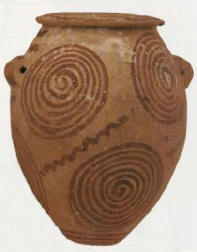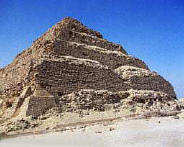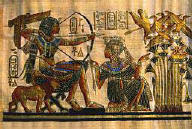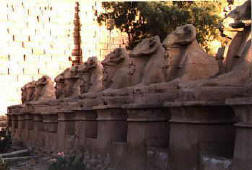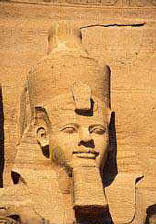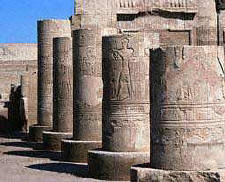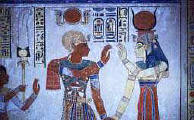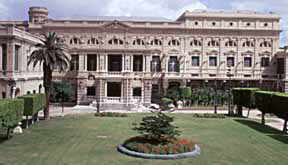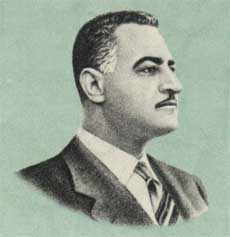|
||||||
History:
Pre-dynastic history
|
Archaeological evidence suggests that hunters inhabited Egypt over 250,000 years ago when the region was green grassland. The Paleolithic period around 25,000BC brought climatic changes, which turned Egypt into a desert. The inhabitants survived by hunting and fishing and through a primitive form of cultivation. Desertification of Egypt was halted by rains, which allowed communities of cultivators to settle in Middle Egypt and the Nile Delta. These farmers grew wheat, flax and wove linen fabrics in addition to tending flocks.
The first indigenous civilizations in Egypt
have been identified in the south of the country through archaeological
excavations. The Badarian culture is the earliest known developed Egyptian
civilization based on farming, hunting and mining. Badarians produced fine
pottery and carved objects as well as acquiring turquoise and wood through
trading.
The Naqada lived in larger settlements about
4,000BC and produced decorated pottery and figurines made from clay and
ivory, which indicate they were a war-like people. Naqada artifacts from
3,300BC show further development both in terms of culture and technology.
Evidence of irrigation systems and more advanced burial sites, as well as
the use of alien materials like lapis lazuli, indicate a cultural diversity
and the development of external trading.
|
|
| Throughout
most of its pre-dynastic history Egypt encompassed a multiplicity of
settlements, which gradually became small tribal kingdoms. These kingdoms
evolved into two loosely confederated states; one encompassed the Nile
valley up to the Delta (with the Naqada dominating) with Hierakonpolis as
capital, represented by the deities Seth and White Crown; the other
encompassed the Delta, with Buto as its capital and represented by the
deities Horus and Red Crown.
The two kingdoms vied for power over all the land of Egypt. This struggle led to the victory of the south and the unification of the Two Lands in 3100BC under the command of Menes who is also known as Narmer. This was the beginning of the dynastic period of the Pharaohs. |
The Early Dynastic or
Archaic Period (3100-2686BC)
This period is shrouded in mythology. Little is
known of Menes and his descendants outside of their divine ancestry and that
they developed a complex social system, patronized the arts and constructed
temples and many public buildings.
| The
foundation of Memphis, the world's first imperial city, is attributed to
Menes. From Memphis the third and fifth kings of the First Dynasty, which
extended from 3100 to 2890BC set out to conquer the Sinai. During the First
Dynasty culture became increasingly refined. The royal burial grounds at
Saqqara and Abydos became sites of highly developed mastabas.
The Second Dynasty
lasting from 2980 to 2686BC was characterized by regional disputes and a
decentralization of Paranoiac authority, a process that was only temporarily
halted by the Pharaoh Raneb, also called These regional
contentions were very likely the outcome of the unresolved conflict between
the two deities Horus in the south and Seth in the Delta. Theistic rivalry
seems to have been resolved by Khasekhem, the last Pharaoh of the Second
Dynasty |
|
The Old Kingdom
(2686-2181BC)
| Paranoiac
burial practices continued to develop during the Third Dynasty, lasting from
2686-2613BC, which marked the beginnings of the Old Kingdom. The first of
Egypt's pyramids were constructed during the 27th century BC. The Step
Pyramid of Saqqara built for King Zoser by his chief architect Imhotep, who
later generations deified, is considered by many to be the first pyramid
ever constructed in Egypt.
Prior to this, most royal tombs were constructed of sun-dried bricks. Zoser's gargantuan step pyramid attested to the pharaoh's power and established the pyramid as the pre-eminent Paranoiac burial structure. During Zoser's rule the Sun God Ra attained a supra-eminent place over all other Egyptian deities. |
|
The Fourth Dynasty (2613-2494BC) was characterized by expansionism and pyramid construction. King Sneferu constructed the Red Pyramid at Dahshur near Saqqara and the Pyramid of Meidum in Al-Fayoum.
| He also
sent military expeditions as far as Libya and Nubia. During his reign
trading along the Nile flourished. Sneferu's descendants, Cheops (Khufu),
Chephren (Khafre) and Mycerinus (Menkaure) were the last three kings of the
Fourth Dynasty. These three pharaohs built the pyramids of Giza.
Egypt under Cheops became the first state in
the history of the world to be governed according to an organized system.
The Fourth Dynasty also extended trade relations with the Near East and
mined and smelted copper in Nubia.
|
|
The Fifth Dynasty (2490-2330BC) was marked by a
relative decline in Paranoiac power and wealth, evidenced by the smaller
pyramids of Abu Sir built during this period. The pharaohs ceased to be absolute
monarchs and began to share power with the aristocracy and high officials. As
the independence of the nobility increased, their tombs became larger and were
built at increasing distances from the pharaohs.
Worship of the sun god Ra also spread during the
Fifth Dynasty. It was during the reign of Unas that religious texts were placed
in the pyramids bearing descriptions of the afterworld, which were later
gathered into the Book of the Dead.
Decentralization of
Paranoiac authority increased during the Sixth Dynasty (2330-2170BC) as small
provincial principalities emerged to challenge Paranoiac power. The Sixth
Dynasty kings were forced to send expeditions as far as Nubia, Libya and
Palestine to put down the separatists, but these campaigns served to further
erode the central authority. By the reign of the last Sixth Dynasty Pharaoh Pepi
II, the Old Kingdom had become a spent force.
|
The First Intermediate
Period (2181-2050BC)
Out of the turmoil and Paranoiac inertia,
principalities within the realm raised up to challenge the authority of the
kings. Achthoes, ruler of Heracleopolis, seized control of Middle Egypt,
seized the throne and founded the Ninth Dynasty (2160-2130BC).
The kings of Heracleopolis maintained control over northern Egypt through the Tenth Dynasty (2130-2040BC). However, the rulers of Edfu and Thebes fought over control of Upper Egypt. Thebes won the battle over Upper Egypt and its ruler Inyotef Sehertowy founded the Eleventh Dynasty (2133-1991BC) with the aim of extending his power over all the land. The north-south battle for control of Egypt
ended with the victory of Nebhepetre Mentuhope II who reunited the country
under one king and launched the Middle Kingdom. |
|
|
The Second Intermediate
Period (1786-1567BC)
The Thirteenth and Fourteenth Dynasties were
powerless to put
down the Hyskos, tribal warlords with foreign support who seized control of the Delta, establishing the capital of Avaris and moving south. Despite their alien origins (Hyskos means "Princes of Foreign Lands") and foreign ties, the Hyskos assumed an Egyptian identity and ruled as pharaohs. The Hyskos dominion was shaken by Thebes,
which established the Seventeenth Dynasty and, under Wadikheperre Kamose,
laid siege to Avaris. When his successor Ahmosis expelled the Hyskos from
Egypt in 1567BC, the New Kingdom was born. |
|
|
The New Kingdom
(1567-1085BC)
Ahmosis founded the Eighteenth Dynasty
(1567-1320BC), which reigned over the first part of a prosperous and stable
imperial period during which Paranoiac culture flowered and Egypt became a
world power.
During the Eighteenth Dynasty Nubia was subdued
and its wealth of gold, ivory, gemstones and ebony flowed into Egypt.
Paranoiac armies conquered the Near East, Syria and Palestine and workers
from these new-established colonies, and a cultural cross-fertilization took
place as artisans and intellectuals transplanted their knowledge, skills and
culture onto Egyptian soil.
The temple of Karnak at Thebes grew with the expansion of empire. Tuthmosis I constructed the first tomb in the Valley of the Kings. His daughter reigned as pharaoh and built the temple of Deir Al-Bahri. Tuthmosis III expanded the empire beyond Nubia and across the Euphrates to the boundaries of the Hittites. Imperial expansion continued under Amenophis
II and Tuthmosis IV. The reign of Amenophis III was the pinnacle of Egyptian
Paranoiac power. Under Amenophis III the kingdom was secure enough for the
Pharaoh to build many of the greatest Paranoiac structures including the
Temple of Luxor.
|
|
His son Amenophis IV fought with the priesthood of
the god Amun and changed his name to Akhenaten in honor of the god Aten. With
his wife Nefertiti Akhenaten he established a new capital at Tel El-Amarna
dedicated to the worship of Aten, which many believe was the first organized
monotheistic religion. Both his predecessors and successors denounced his
beliefs as heresy.
During their short reign (1379-1362BC) Paranoiac
obsession with the afterlife was banished, as was the old idolatry. Art began to
reflect human concerns. This was called the Amarna revolution, which barely
survived
Akhenaten's reign. His successor Smenkhkare upheld
Akhenaten's ideals but died within a year, leaving the child pharaoh Tutankhamen
under the influence of the priesthood who easily convinced him to renounce the
monotheism of his father-in-law and return to rule from Thebes.
This period has been called the Theban
counter-revolution during which time the priesthood destroyed any traces of
Akhenaten's reign, including the Temple of the Sun at Karnak.
Tutankhamen ruled for nine years until just before
reaching manhood, when he died. He is most remembered in modern times for the
fabulous and pristine treasures uncovered when his tomb was discovered in 1922.
Ay and Horemheb, the last Eighteenth Dynasty kings, both of whom worked to eradicate Akhenaten’s revolutionary beliefs and restore the status quo, succeeded Tutankhamen.
|
The Nineteenth Dynasty
(1320-1200BC)
Was established by the Horemheb's wazir, or
minister, Ramses I who reigned for two years. Ramses and his descendants
were warrior kings who recaptured territories lost under Akhenaten. His
successor Seti I regained controls over Egypt's eastern colonies in
Palestine, Nubia and the Near East. Seti I also began construction on a
majestic temple at Abydos, which was completed by his son Ramses II who
reconquered Asia Minor.
Ramses also constructed monumental structures
like the Ramesseum in Thebes and the sun temples of Abu Simbel. His son
Merneptah spent much of his reign driving back invaders from Libya and the
Mediterranean but he is believed to be the biblical Pharaoh described in
Exodus. Seti II was the last king of the Nineteenth Dynasty.
The Twentieth Dynasty (1200-1085BC) was to be the last of the New Kingdom and was first established by Sethnakhte. By the reign of his successor Ramses III, the kingdom was occupied with defending itself against Libyan and "Sea People" invasions. Ramses III constructed the enormous palace temple of Medinet Hebu but the empire had begun to disintegrate with strikes, assassination attempts and provincial unrest. His successors, who were all named Ramses,
presided over the decline of their empire until Ramses XI withdrew from
active control over his kingdom, delegating authority over Upper Egypt to
his high priest of Amun, Herihor, and of Lower Egypt to his minister Smendes.
These two rulers were the last of the New Kingdom. |
|
The Late Period (1085-322BC)
The Twenty-First Dynasty was established by
successors of Herihor and Smendes who continued to rule Upper and Lower Egypt
separately from Thebes and Tanis. But by this period external threats from
Libyan invaders and others were eroding Egypt's power to defend itself.
Eventually both Upper and Lower Egypt succumbed to foreign invasions. Libyan
warriors who established their own Twenty-Second Dynasty drove the Tanites from
power.
Upper Egypt held out longer against Nubian invaders
until being overrun by the armies of their ruler Piankhi all the way to Memphis.
Piankhi's brother Shabaka marched north to conquer the Delta and reunite Upper
and Lower Egypt under the Twenty-Fifth Dynasty of Nubian Kings (747-656BC).
During this period there was an artistic and cultural revival. The Twenty-Fifth
Dynasty ended when Assyrian armies captured Memphis and attacked Thebes, driving
the Nubian pharaoh Tanutamun back to Nubia.
The Assyrians found a willing Egyptian collaborator
in the form of a prince from the Delta. Psammetichus I governed on behalf of the
Assyrians until they were forced to withdraw their forces to wage war against
the Persian Empire. On the departure of the Assyrians, Psammetichus I declared
himself pharaoh and established the Twenty-Sixth Dynasty, ruling over a
re-united Egypt from his capital at Saïs in the Delta. This was to be the last
great Paranoiac age, which witnessed the revival of majestic art and
architecture and the introduction of new technologies.
|
Gradually, though, the power of the kingdom was eroded
through invasion, ending ignominiously when Amasis, "the Drunkard", was
forced to depend on Greek forces to defend his Kingdom against the onslaught
of Persian imperial armies. The Persians first invaded Egypt in 525BC, initiating a period of foreign domination of the country, which lasted until 1952, when an Egyptian republic replaced the monarchy of King Farouk. The conquering Persians established the Twenty-Seventh Dynasty (525-404BC), which ruled Egypt with an iron hand. The Persians first invaded Egypt in 525BC,
initiating a period of foreign domination of the country, which lasted until
1952, when an Egyptian republic replaced the monarchy of King Farouk. The
conquering Persians established the Twenty-Seventh Dynasty (525-404BC),
which ruled Egypt with an iron hand.
|
|
|
The Persians, under the emperors Cambyses and
Darius, completed a canal connecting the Nile with the Red Sea, which had
been started by the Twenty-Sixth Dynasty king Necho II. They also
constructed temples and a new city on the site of what is now called Old
Cairo. This was called Babylon in Egypt.
The harshness of Persian rule resulted in
revolts against the Persian satraps Xerxes and Artaxerxes, which led to the
Twenty-Eighth dynasty of the Egyptian ruler Amyrtaeus and his successors.
The Egyptian kings of succeeding dynasties were under continual attack by
Persians until Artaxerxes III overthrew the Thirtieth and final Paranoiac
dynasty, remaining under Persian domination until the arrival of Alexander
the Great in 332BC. |
|
Greek Rule (332-30BC)
After centuries of upheaval and foreign incursions,
Egypt was in disarray when Alexander established his own Paranoiac rule,
reorganizing the country's government, founding a new capital city of Alexandria
and validating the religion of the pharaohs.
Upon his death in 323BC, the empire of Alexandria
was divided among his Macedonian generals. Ptolemy I thus established the
Ptolemaic Dynasty, which ruled Egypt for three centuries. Under the Ptolemys
Greek became the official language of Egypt and Hellenistic culture and ideas
were introduced and synthesized with indigenous Egyptian theology, art,
architecture and technology. The Ptolemy's synthesis of religious ideas resulted
in the construction of the temples of Edfu and Kom Ombo, among other sacred
structures. Alexandria became a great capital, housing one of history's greatest
libraries.
Gradually Ptolemaic rule was subverted by internal
power struggles and foreign intervention. The Romans made inroads into Ptolemaic
Egypt, supporting various rulers and factions until attaining total control over
the country when Julius Caesar's armies attacked Alexandria.
Queen Cleopatra VII was the last of the Ptolemaic
rulers who reigned under the protection of the Caesar with whom she had a son.
With the assassination of Caesar, Mark Antony arrived in Egypt and fell in love
with Cleopatra, living with her for 10 years and helping Egypt retain its
independence. The fleets of Octavian Caesar destroyed the Egyptian navy in the
battle of Actium, driving Antony and Cleopatra to suicide and Egypt became a
province of the Roman Empire.
Roman and Byzantine Rule
(30BC-AD638)
Octavian Caesar became the first Roman ruler of
Egypt, reigning as the Emperor Augustus. Egypt became the granary of the Roman
Empire and remained stable for about 30 years. The Romans, like their Greek
predecessors, synthesized many Egyptian beliefs with their own, building temples
at Dendara and Esna and Tranjan's kiosk at Philae. Hellenism remained a dominant
cultural force and Alexandria continued to be a centre of Greek learning.
The Christian era began in Egypt with the
spectacular biblical Flight of the Holy Family from Palestine. To this day
shrines and churches mark the stages of the journey of Mary, Joseph and their
infant Jesus. According to Coptic tradition, it was not until the arrival of
Saint Mark that Christianity was established in Egypt during the reign of Nero.
Saint Mark began preaching the gospel in about AD40 and established the
Patriarchate of Alexandria in AD61.
The Egyptian Coptic Church expanded over three
centuries in spite of Roman persecution of Christian converts throughout the
Empire. In AD202 the Roman authorities, continuing for nearly a century,
initiated persecutions against Copts. In AD284, during the reign of the Emperor
Diocletian, a bloody massacre of Coptic Christians took place from which the
church has dated its calendar. Christianity was legalized and adopted as the
official religion of the Roman Empire by the Emperor Constantine.
By the 3rd century AD the Roman Empire was in
decline as a result of internal strife, famine and war, finally splitting into
eastern and western empires. The Eastern Empire based in Constantinople became
known as the Byzantine Empire. The Western Empire remained centered in Rome. The
legalization of Christianity did not stop Roman persecution of the Coptic
Christians because the Byzantine church was based upon fundamentally different
beliefs than those of the Coptic Christian church which had adopted a
Monophysite belief in the total divinity of Christ, as opposed to the Byzantine
belief that Christ was both human and divine. The schism between the Byzantine
and Coptic churches was never closed.
The Copts were formally excommunicated from the
Orthodox Church at the Council of Chalcedon in AD451 and established their own
Patriarchate at Alexandria. The fifth century was also a time when monasticism
emerged and the Coptic monasteries of Saint Catherine, Saint Paul and Saint
Anthony were established as well as those at Wadi Natrun and Sohaag.
Apart from this doctrinal upheaval, the Byzantine rule over Egypt remained relatively stable until the coming of Islam.
The Early Islamic Period
(640-969)
Under the first Khalif of Islam Abu Bakr As-Siddiq,
the Prophet Muhammad's closest companion, the Muslim armies vanquished the
Byzantines in AD636. They advanced toward Egypt under the command of Amr Ibn
Al-As, one of the companions of the Prophet.
The Muslims laid siege to Babylon-in-Egypt, which
surrendered. They then took Heliopolis and in AD642 the Byzantine imperial
capital of Alexandria. Amr Ibn Al-As established Fustat north of
Babylon-in-Egypt as his military headquarters and seat of government and the
Egyptians swiftly embraced the new religion of Islam.
Egypt became part of an expanding empire that was
soon to stretch from Spain to Central Asia. The Umayyad Dynasty ruled Egypt from
Damascus until the Abbassids took control of the Khalifate and shifted the
political capital of Islam to Baghdad.
Ahmad Ibn Tulun who had been sent by the Abbassid
Khalif Al-Mu'taz to govern Egypt in AD868, declared Egypt an independent state
and successfully defended his new domain against the Abbassid armies sent to
unseat him. His dynasty ruled Egypt for 37 years. Ibn Tulun built Al-Qitai, a
new capital centered on a vast central mosque, the courtyard of which could
accommodate his entire army and their horses. But Tulunid rule was quickly ended
by the Abbassids, who retained direct control over Egypt until Mohammed Ibn
Tughj was appointed governor over the province and granted the title Ikhshid,
allowing him to rule independently of khalifa's controls.
The Ikhshidid Dynasty ruled from AD935-969 when Shi’a Fatimia armies from Tunisia invaded Egypt.
|
The Fatimia Period
(969-1171)
The Fatimid Dynasty traced their lineage from
the Prophet's daughter Fatima Zahra and her husband Ali Ibn Abu Talib. They
embraced Shi'a doctrines which rejected the legitimacy of the first three
Khalifs of Islam, Abu Bakr, Omar and Othman, who they claimed to be usurpers
of Ali's right to succeed the Prophet in leading Islam.
At first the Shi'a, or Partisans of Ali, were loyal members of the Muslim umma who simply disagreed with the political decision to bypass Ali. However Umayyad machinations which lead to the assassination and martyrdom of Ali and his sons Hassan and Hussein, hardened Shi'a attitudes and led to a religious schism with metaphysical overtones, which has persisted to this day. The Fatimids had separated themselves from
the Sunni Khalifate and set up their own western khalifate, which, with
their conquest of Egypt in AD969 extended across North Africa. The Fatimids
established their imperial capital within the walls of a newly built
imperial city called Al Qahira (Cairo), meaning "The Triumphant". Within the
walls of the city were lavish palaces and the Mosque of Al Azhar and its
University, which is now the world's oldest existing institution of
learning.
|
|
Egypt flourished under the Fatimids who ruled
behind the walls of their imperial city, maintaining the mystery of distance
from their subjects. It was not until the reign of the demented Khalif Al-Hakim
that the Fatimid decline began.
Although beginning his rule beneficently, building
a splendid mosque between Bab Al-Futuh and Bab An-Nasr in Cairo, and emerging
from his palace to meet his subjects to get a better understanding of their
needs, Al-Hakim degenerated into a murderous despot. He executed anyone to whom
he took a disliking and ruled with insane caprice. When he became enamored
of staying up all night, he made sleeping at night and working during the day
punishable by death. He banned the making of women's shoes. He also banned the
consumption of molokhia, a vegetable resembling spinach, which is a staple in
the Egyptian diet. He supported the Byzantines against Roman Christians and
the destruction of the Holy Sepulcher in Jerusalem, which was a pretext for the
First Crusade.
His reign ended mysteriously when Al-Hakim rode his
favorite mule up into the Mokattam hills at night. The mule was found but
Al-Hakim had vanished. Although it is likely that bandits who roamed the
outskirts of the city murdered him, hiding out in the hills or in the City of
the Dead, his disappearance was mythologized by his more extreme Shi'a followers
who believed that he was divine and had ascended to a spiritual realm.
Curiously, this heretical sect gained adherents and became known as the Druse
who still has communities in Lebanon, Syria, Jordan and Israel. Although the
Druse are clearly neither Muslim (Shi'a or Muslim), Christian or Jew, their true
beliefs remain shrouded in mystery as only the Druse priesthood are privy to
their doctrines and ordinary adherents are kept in total ignorance until the age
of 40.
Fatimid rule continued over Egypt for another 150
years and the country continued to prosper. However their empire gradually
declined due to famine, internal troubles and external pressure from the Seljuk
sultans who captured Syria from the Fatimids, and the Christian crusading
armies, which conquered Fatimid Palestine and the Lebanon. To protect the
remainder of their diminishing empire, the Fatimids collaborated with the
Franks, an act which outraged the Seljuk Sultan Nurad'din who sent an expedition
to overthrow the Fatimids.
The Sultan deputized his general Shirkoh to repel the Fatimid and Frank armies and conquered Upper Egypt, sending his nephew Salah al-Din Al-Ayyubi to capture Alexandria, thus opening the way for the Ayyubid Dynasty.
Ayoubid Rule (1171-1250)
Salah al-Din Al-Ayyubi ("Saladin") assumed control
of Egypt upon the death of the last Fatimid Khalif in 1171.
When the Crusaders attacked Egypt, burning part of
Cairo, Salah al-Din fortified the city and built the Citadel. His reign was a
golden age for Egypt and Salah al-Din is revered as one of the greatest heroes
of Islam, for his humility, personal courage, brilliant military and
administrative mind and for defeating the Christian armies and treating the
vanquished with dignity.
Salah al-Din spent eight years of his 24-year reign
in Cairo during which time he established the Seljuk institution of the madrassa,
built hospitals and other infrastructure. Salah al-Din also introduced Mamlukes
(an Arabic word meaning "owned"), Turkic slaves from the Black Sea region who
had been raised as mercenary soldiers. Under Salah al-Din and his successors
the Mamlukes were given a measure of freedom to own land and raise families and
some rose to positions of power and influence.
Upon the death of Salah al-Din in 1193, his brother, al-Adil, succeeded him following a protracted succession dispute. Al-Adil died in Syria, upon hearing the news of the crusaders' seizure of the chain bridge (burj al-silsila) at Damietta in 1218. His son and Salah al-Din’s nephew, al-Kamil, who drove back the Fifth Crusade, succeeded him. His successor, Sultan Ayyub, increased the size of his Mamluke army and married a slave girl called Shagarat Ad-Durr (Tree of Pearls). When Ayyub died, his wife became the first woman to rule Egypt since Cleopatra. She was the last ruler of the Ayyubids. Prophetic injunctions against women rulers placed Shagarat Ad-Durr in an untenable position and the Abbassids forced her to take a husband. When her new husband, Aybak, planned to take a second wife, Shagarat Ad-Durr had him murdered. She was assassinated shortly after this and the Mamluke military commander Baybars assumed control, ushering in the Mamluke period.
The Mamluke Period
(1250-1517)
Baybars, one of the great Ayyubid commanders,
seized power in the aftermath of Shagarat Ad-Durr's murder but his heirs were
murdered by Qalawun, another Mamluke who established the Bahri Mamluke dynasty,
named after the Mamluke garrison along the Nile River (Bahr Al-Nil). During his
reign Sultan Qalawun became a great patron of architecture and constructed
mosques, fortresses and other buildings in Cairo. Qalawun also established
relations many foreign countries in Europe, Africa and Asia. Qalawun's son
and successor, Mohammed An-Nasir who reigned for nearly half a century, from
1294-1340, was also a great patron of architecture.
The Mamluke armies of Sultan Mohammed An-Nasir
shocked the seemingly unstoppable Mongol armies by defeating them on the Syrian
battlefield. The descendants of Mohammed An-Nasir were weak and the Turkish
Bahri Mamluke dynasty gradually lost control of the sultanate, which was seized
by the Circassian Mamluke Barquq who established the Burgi Mamluke dynasty,
named after the Mamluke garrison set beneath the Citadel In Cairo. Although
Sultan Mohammed An-Nasir had made a treaty with the Mongols, they remained on
the borders of Syria and Sultan Barquq campaigned against the Mongols to drive
them out of the Near East altogether.
Heavy taxation was levied to pay for these
campaigns, debilitating the economy of Egypt. Conditions were exacerbated by a
plague that swept through the country during the reign of Barquq's son Farag. It
was not until the reign of Sultan Barsbey that Egypt regain its power. Barsbey
recognized the rising power and potential threat of the Ottoman Turks and
established good relations with them. He also extended Mamluki trade.
Nevertheless, the Mamluke economy remained unstable for nearly a century until
the reign of Sultan Qait Bey, another great Mamluki builder, who constructed
mosques, madrassas and other buildings throughout the empire.
The 46th Mamluki sultan was Qansuh Al Ghuri who continued the Mamluki architectural tradition but saw his economy crash after European traders began using the Cape of Good Hope for their spice trade rather than trading through Cairo. To add insult to injury, the Ottomans attacked Mamluke Syria and Sultan Qansuh fell in battle in 1516. The following year Tuman was executed by the Ottomans, signaling the end of the Mamluke Empire and the beginning of Ottoman rule, but the Mamlukes remained a powerful force within Egypt throughout the Ottoman period and beyond.
Ottoman Rule (1517-1798)
Although the Ottoman Turks were brilliant military
strategists and developed a rich Islamic civilization, they were poor colonial
administrators. They ruled Egypt from Istanbul through Pashawat who were trained
in Istanbul. Their direct involvement in government rarely extended to more than
enforcing tax collection. Otherwise the Ottomans exercised minimal control over
their new province and relied on the Mamluke army whose ranks continued to
expand with mercenary slaves brought in from the Caucasus. This lack of concern
manifested in neglect and deterioration, which opened the way for the French
invasion of Egypt in 1798.
European conquest
(1798-1802)
The armies of Napoleon crushed the Mamlukes at
Imbaba and occupied Cairo. Napoleon's aim was to block British trade routes to
India and to establish a Franco phonic society in Egypt. He imposed a French
administrative system and implemented public works projects to clean up and
renovate the long-neglected country, clearing blocked canals, cleaning the
streets and building bridges. Napoleon claimed to have respect for Islam and the
Qur'an but the Egyptians did not believe him.
For all his attempts at "civilizing" the country,
Napoleon failed to win the respect or allegiance of his subjects. His quixotic
mission was doomed from the outset. Within a month of entering Egypt the
British, under Admiral Nelson, attacked and destroyed the French fleet moored at
Abu Qir Bay in Alexandria and the Ottoman sultan threatened war against the
French. Napoleon returned to France, leaving his armies behind. But his
commander, General Kléber, was assassinated, leaving the army to General Menou,
who claimed to have converted to Islam and declared Egypt, a French
protectorate. At this, the British occupied Alexandria and with the Ottomans
captured Damietta and Cairo, forcing the French to surrender.
The Napoleonic invasion of Egypt had profound
repercussions for the Arab and Muslim world, which continue to influence the
region's political and social development. This was the first European conquest
of a major Arab country in the history of Islam and it signaled the rapid
decline of Islam as a world political power. Although it could be said that the
Ottoman Empire was by this time already a spent force, the humiliation of
Napoleon's entry into Egypt was a devastating blow to pan-Islamic pride. It has
been said that contemporary Muslim fundamentalism traces its psychological
origins to this initial shattering defeat.
The Dynasty of Mohammed Ali
Pasha (1802-1892)
The French occupation destabilized Egypt and their defeat and withdrawal left the country vulnerable to an internal political struggle, which was won by Mohammed Ali, an Albanian lieutenant in the Ottoman army who, with Mamluke help, drove the British (temporarily) out of Egypt. The Ottomans elevate him to khedive or viceroy of Egypt.
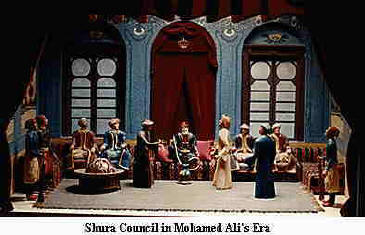
In order to consolidate his power, the new khedive
realized he had to eradicate Mamluki power, which he did decisively and
spectacularly. After six years as ruler he invited 470 Mamluke soldiers to a
banquet at the Citadel. It was a trap. All were massacred and the Mamluke threat
was ended.
Although Mohammed Ali was nominally a representative of the Ottoman Sultan he was for all intents and purposes an absolute ruler.
|
He was dedicated to the modern development of
Egypt, building factories, railways and canals, bringing in European
architects and technicians to create a modern state.
Mohammed Ali was also an ambitious expansionist
whose armies extended his power over Syria, Sudan, Greece and the Arabian
Peninsula until by 1839 he controlled a large portion of the Ottoman Empire.
Throughout his reign, however, Mohammed Ali always kept up the pretence of
being a loyal representative of the Khalif. When it became clear that his
power was exceeding acceptable limits, the British intervened, forcing him
to relinquish some control to the Ottoman sultan. Mohammed Ali died in 1848
leaving his grandson Abbas to succeed him. Abbas opened Egypt to free trade,
closing schools and factories and effectively halting the moves towards
industrial development and economic self-sufficiency Mohammed Ali had set in
motion.
Said Pasha, the son and successor of Abbas, reversed his father's policies and actively set about developing the country's infrastructure and initiated the building of the Suez Canal, which was completed in 1869 by his successor the Khedive Ismail. Under his rule, industrial and civil infrastructure was further developed. More factories were built. A telegraph and postal system was established. Canals and bridges were constructed and the cotton industry, which had been introduced during the reign of Mohammed Ali, began to flourish as a result of the American Civil war, which prevented southern cotton production for the duration of the war. However, all this expansion had a price.
Ismail's modernization put Egypt heavily into debt and the end of the Civil
War and resumption of American cotton production caused a major recession in
Egypt's cotton industry. As a result of this economic crisis, Khedive Ismail
was forced to abdicate in 1879 and the British began to assume greater
control over the country. |
|
British Occupation
(1882-1952)
Ismail's son Tewfiq Pasha reformed the Egyptian
economy and relinquished financial control to the British who began to run the
government of the country. Egyptian nationalists, horrified at Tewfiq's
submission to the British, forced him to appoint their leader Ahmed Orabi as
Minister of War, but the European reaction was swift and violent. Alexandria was
shelled and Ismailiyya occupied. Orabi's army was defeated at Tel El Kabir and
the British reinstalled Tewfiq as a puppet. Orabi was driven into exile and
Mustafa Kamil became the leader of the nationalist movement.
British influence over Egypt continued to increase.
The country became an economic colony, totally dependent upon the import of
British manufactured goods and the export of its raw cotton.
The outbreak f the World War I brought Egypt
formally into the British Empire as a Protectorate when the Ottoman Sultan
declared his support for the Germans against the allies. During the war Fouad,
the sixth son of Khedive Ismail, had become Khedive of Egypt but his authority
was to be constantly challenged by Egyptian nationalists who fed on the popular
resentment of foreign domination.
Sa'ad Zaghloul was the leader of the nationalist
movement during and after the war and in 1918 he formally presented the British
High Commissioner with a demand for complete autonomy, which was rejected out of
hand. Zaghloul's eventual arrest and deportation to Malta resulted in widespread
anti-British riots, forcing the British to back down.
| In 1922 the
British ended the protectorate and recognized Egypt's independence, while
maintaining control over the essential government institutions and the Suez
Canal. Fouad was proclaimed King of Egypt in March of the same year.
A triangular power struggle between the British, the King and the nationalist Wafd party, which had the support of the population, characterized the years that followed.
Farouk, the son of King Fouad, ascended the
Egyptian throne in 1935. In the beginning, the reign of King Farouk was
greeted with enthusiasm by both the Wafd party and by the rapidly growing
Muslim Brotherhood. Farouk was, amazingly, the first Egyptian ruler of the
descendants of Mohammed Ali Pasha to speak fluent Arabic. Turkish had
been the court language of all his predecessors. Moreover, Farouk seemed to
have nationalist sympathies. The young ruler was, unfortunately, too
weak-willed to defy the British. Within a year he had signed the
Anglo-Egyptian Treaty, which gave British forces the right to remain in the
Suez Canal Zone while ostensibly ending the British occupation of Egypt.
|
|
With the outbreak of World War II the Wafd Party
threw its support behind the allies on the understanding that Egypt would gain
full independence once the war was over. But the hatred of British rule was so
intense by this time that clandestine support for the Germans existed in
nationalist factions like the Muslim Brotherhood.
Egypt became a major strategic asset and base of
operations during World War II. Cairo and Alexandria were filled with soldiers,
spies, political exiles and government leaders. The decisive battle in the North
African campaign was the Battle of El-Alamein in the desert outside Alexandria.
General Montgomery's Eighth Army drove back Rommel's Afrika (Africa) Korps and
the allies swept across North Africa to victory.
With allied victory and the end of the war the Wafd
party called for the immediate evacuation of British troops from Egypt. The
British were slow to respond and Egyptian resentment exploded in anti-British
riots and strikes, instigated by the highly organized Muslim Brotherhood under
the leadership of Hassan Al-Banna which had grown in power and influence during
the war years.
It had always been the Muslim Brotherhood position
that the war between the allies and the axis had nothing to do with Egypt or
Muslims. The leadership of the Muslim Brotherhood refrained from open opposition
to Egyptian support for the allies during the war years but lashed out at the
British presence after the war. Under joint pressure from the Brotherhood and
the Wafd, British troops were evacuated from Alexandria and the Canal Zone in
1947.
The following year the Arab world suffered a
shattering blow when the smaller Israeli army ignominiously defeated a joint
Arab invasion of the newly declared state of Israel. Ashamed and appalled by the
decadence and gross incompetence of their leaders, a group of idealistic young
Egyptian officers were to emerge as leaders of a revolution, which would alter
the course of modern Arab history.
When parliamentary elections were held in 1952 the Wafd Party won the majority of seats and Nahas Pasha as prime minister repealed the 1936 treaty, which gave Britain the right to control the Suez Canal. King Farouk dismissed the Prime Minister, igniting anti-British riots, which were put down by the army.
| This event compelled a secret
group of army officers, which became known as the Free Officers, to stage a
coup d'etat and seize control of the government. King Farouk was forced to
abdicate and General Naguib -- as the most senior officer, the nominal
leader of the group -- became Prime Minister and commander of the armed
forces.
In reality a nine-man Revolutionary Command
Council (RCC) led by Colonel Gamal Abd Al-Nasser ruled Egypt and ruled
decisively. The monarchy was abolished, all political parties (including the
Wafd) were banned and the Constitution was nullified.
|
|
In 1953 the Egyptian Arab Republic was declared. In the beginning, the rule of the Revolutionary Command Council seemed benign and heroic. Their coup had been bloodless, their reforms popular. But the RCC became increasingly radical and when the older Naguib tried to exert some control over the younger officers he was placed under house arrest and removed from power in 1954. Abd Al-Nasser became acting head of state and in 1956 officially assumed the presidency of the republic.
Nasserist rule (1956-1970)
| Gamal Abd-Al
Nasser was a charismatic, ruthless and brilliant political leader who
transformed pan-Arab politics and left a troubled legacy to Egypt and the
Arab world. There is little doubt that Nasser was a sincere Egyptian patriot
who wanted to improve the lot of his people. But he was also a man utterly
committed to the retention of power at any cost, which quickly evolved
into a harsh, repressive socialist-style dictatorship. Those involved in
political opposition were persecuted, driven underground, imprisoned,
tortured, exiled or executed.
Gamal Abd-Al Nasser was a charismatic,
ruthless and brilliant political leader who transformed pan-Arab politics
and left a troubled legacy to Egypt and the Arab world. There is little
doubt that Nasser was a sincere Egyptian patriot who wanted to improve the
lot of his people. But he was also a man utterly committed to the retention
of power at any cost, which quickly evolved into a harsh, repressive
socialist-style dictatorship. Those involved in political opposition were
persecuted, driven underground, imprisoned, tortured, exiled or executed.
|
|
The Muslim Brotherhood, which had initially
supported the 1952 revolution, was outlawed and thousands of its members were
imprisoned. The Wafd suffered a similar fate. Journalists who disagreed with the
regime were silenced. A totalitarian pall fell over Egypt during the Nasser
years. Industry and then private property was nationalized.
Ironically, as he was rounding up the opposition,
Abd-Al Nasser achieved unprecedented popularity throughout the Arab world. He
was admired for his rousing support of Arab Nationalism; his domestic social
programs(which, for the first time in Egypt's history, sought to better the lot
of the peasant majority); his dramatic nationalization of the Suez Canal; and
also because of Egypt's heroic stand against the British invasion.
However Nasser's vehement opposition to Israel and
his outspoken criticism of the West lost him US and European support for the
building of the Aswan High Dam, forcing the Egyptian president to turn to the
Soviets for aid. The need for capital to build the High Dam is cited as one of
the reasons for nationalizing the Suez Canal.
Whatever Nasser's initial intentions, the Suez
Crisis propelled him to the forefront of the Arab Nationalist movement. Pan Arab
unity became the overriding theme of the Arab world from the late 1950s up to
1967 and Nasser became its chief advocate and spokesman. The most dramatic
display of Pan-Arabism took place in 1958 when Egypt united with Syria to form a
single country, the United Arab Republic. But Nasser, for all his oratory, was
essentially an Egyptian nationalist. The practical interests of the two
countries never meshed and the union came to nothing.
But Nasser's revolutionary pan-Arabism was not all
talk. Egypt entered the Yemeni civil war against the monarchy on the side of
leftist guerrillas, further alienating the west and Saudi Arabia. At the same
time he strengthened Egypt's ties to the Soviet Union, relying on the communist
bloc for technical and military assistance to build an army to fight the US
supported Israeli army. Nasser also supported the formation of the Palestine
Liberation Organization, further alienating him from the West.
Nasser's relations with the West were complex. He
knew that he could never develop Egypt without large infusions of foreign aid
and he knew that the West was the most reliable source of this aid. Yet he came
to discover that the more anti-Western his stance appeared to be, the more
foreign aid he was offered by western countries to buy his moderation. When at
one point in his regime he became more conciliatory to the west, his foreign aid
dropped dramatically. As a founding-leader of the Non-aligned movement Nasser
could have it both ways. Along with India's Nehru and Indonesia's Sukarno, Gamal
Abd-Al Nasser became a major international power broker in the politics of the
developing world.
Nasser's pan-Arab politics of the period tend to
overshadow the achievements of his regime. Land reform was put into effect,
breaking up the large feudal estates into smaller parcels of land and
redistributing land to the fellaheen who for millennia had been an underclass of
serfs. When the Aswan High Dam was completed, arable land in the Nile Valley
increased by 15%. Nasser also built the country's industrial base, powered by
electricity generated from the High Dam.
Prior to the revolution, Egypt had been an elitist
society with few if any state-sponsored benefits to the large majority of the
population. The new government established extensive free educational programs
for both boys and girls and developed the country's medical infrastructure.
The country had to pay a heavy price for much of
this development. Political repression and censorship increased. The educated
classes and political elite who could have contributed to the building of the
country were disenfranchised and persecuted. An under-educated socialist
bureaucracy which provided Nasser with his power base, but which was grossly
incompetent, setting the lowest possible standards for the administration of a
great country, replaced them. Economic stagnation and industrial and
agricultural inefficiency subverted real development. Rhetoric had replaced
reality.
The Six-Day War in 1967 marked the end of Nasser's
Pan-Arab dream. The Arab world's ignominious defeat by Israel ended in the
Israeli occupation of Syria's Golan Heights, the Gaza Strip and the West Bank in
Palestine and, most painfully for Egypt, the Sinai. However, the greatest
symbolic humiliation for the Arabs was the fall of Jerusalem. The bombastic
rhetoric of Arab leaders now seemed like so much hot air. Hatred of Israel and
its chief supporter, the United States, reached a pinnacle.
The defeat of the Egyptian army and the loss of Sinai would have destroyed the political career of an Arab leader of lesser stature and indeed, Abd-Al Nasser offered to resign as president. Such was his extraordinary popularity that the Egyptian people staged massive spontaneous demonstrations in support of the president and he remained in power. His death in 1970 of a heart attack sent shock waves throughout the Arab world. In a stunning display of emotion, millions of Egyptians followed his funeral procession through the streets of Cairo.
The rule of Sadat (1970-1981)
Anwar Saddat had been one of the original Free
Officers and served as Nasser's vice-president and chosen successor, but he had
never been taken seriously until he assumed control of the government. Saddat
began to systematically reverse the failed socialist policies of his
predecessor, ultimately expelling the Soviets and reforming the economy. But it
was Saddat's surprise attack against Israeli forces in the Sinai on the Jewish
holiday of Yom Kippur during the Muslim holy month of Ramadan on October 6,
1973, which gave Sadat the credibility, which earned the respect of his
countrymen. The October War shattered the image of Israeli invincibility, which
had persisted since the Six Day War and gave the Arab world a tremendous
psychological boost. Although the war turned against the Arabs and ended in a
stalemate, Sadat emerged as a hero.
Sadat then set about liberalizing the Egyptian
system. Political prisoners were granted amnesty, censorship of the press was
lifted and political parties were allowed. Sadat also made a show of reversing
the harsh secularism, which was beginning to alienate the still traditionally
religious middle classes by strongly identifying himself as a devout Muslim. At
the same time, he instituted the Infitah, or Open Door policy, encouraging
foreign investment and the development of the private sector. Gulf Arab
investments began to flow into the country and international investment and
foreign aid increased.
Still, the specter of another debilitating war with
Israel loomed. After years of socialist privation and militarism the Egyptian
people had had enough. Although there were still echoes of pan-Arabism, the
booming oil-producing Gulf economies had undergone a shift in attitude. At the
same time, Egypt was facing pressure from the International Monetary Fund to
remove the food subsidies, which were sapping the country's financial reserves.
Sadat knew that this would undermine his political
power so, instead of graduating the removal of subsidies, he did it in a single
day at the beginning of 1977, and causing prices to double suddenly and igniting
what have been called the food riots. It was a brilliant ploy, which caused the
IMF to back down and reschedule Egypt's loans and the US to increase its foreign
aid to the country. Food subsidies were immediately reinstated.
Sadat made his most dramatic and controversial
political move later the same year. On November 19, 1977 Sadat suddenly traveled
to Jerusalem with overtures of peace to Israel. On a global level the move was
brilliant, catapulting Sadat to the front ranks of international diplomacy.
Sadat became the darling of the west and gave the Arab world a new image of
moderation.
On a domestic and regional level, Saddat’s peace
initiative was to outrage the Arab world and alienate the president from many of
his people. Never as charismatic as his predecessor, Sadat was perceived as a
traitor, toadying to western interests. Egypt was the first Arab state to
recognize Israel's right to exist and the subsequent Camp David agreements,
which won Sadat and Israeli Prime Minister Menachem Begin the Nobel Peace Prize,
further isolated Egypt from the rest of the Arab world. The Arab League
relocated from Cairo to Tunis and many Arab countries severed diplomatic and
trade relations.
Saddat’s cultivation of the West, which was
initially greeted with enthusiasm by most Egyptians, began to backfire after the
peace initiative. Economic liberalization, which brought wealth to the upper and
middle classes, brought inflation to the country and increased the poverty of
the lower classes.
Saddat’s support for Islam also began to backfire as groups like the Muslim Brotherhood gained wider support and became more vocal in their criticism of government economic policies and the Camp David agreements, which were portrayed as a sell out to the Zionists. Militant fundamentalist groups throughout the Arab world and in Egypt began to call for Saddat’s overthrow or assassination. After relaxing government repression Sadat resorted to wide-scale arrests and the western media who had coddled him since Camp David, suddenly turned on the president.
In October 1981 Sadat was assassinated at a military parade. He had become so isolated from his people by this time that his death and funeral elicited little reaction from a people that had poured into the streets in grief when his predecessor had died.
The rule of Mubarak
(1981-present)
| Mohammed
Hosni Mubarak had been Sadat's vice-president since 1974 and, like Sadat,
seemed singularly unimpressive prior to assuming the presidency. At first he
continued Sadat's policies but with less flamboyance and more domestic
sensitivity. He allowed the publication of Islamic newspapers and downplayed
the Israeli connection. At the same time, he accelerated the process of
privatization and developed Egypt's tourist infrastructure, which enhanced
its lucrative tourist industry.
More impressively, he managed to resume
diplomatic and trade relations with moderate Arab countries while
maintaining the treaty with Israel. By the end of the 1980s Egypt was once
again playing a leading role in Arab politics. Egypt's vital role in support
of Saudi Arabia and Kuwait in the Gulf War combined with death of
socialist-communist influence in the Arab world returned the country to the
centre of Middle Eastern politics.
|
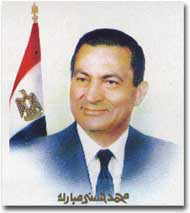 |
However, Egypt's domestic situation is far from
stable. The country's economic reforms and infrastructure development cannot
keep pace with the population explosion and inflation. Extremist Muslim groups
launched a campaign of terrorism against foreigners, which paralyzed the
government and damaged tourism between 1992 and the beginning of 1994. But
security forces broke the main terrorist groups in Cairo and Upper Egypt and the
summer of 1994 experienced a spectacular revival of tourism, particularly from
Saudi Arabia and the Gulf States.
Although most terrorist cadres have been imprisoned
and many have been sentenced to death, the threat to Egypt's stability remains,
as Islamic fundamentalism becomes more deeply rooted in Arab societies.
President Hosni Mubarak was sworn in for a further six-year term in office on 5 October 1999. Mubarak, the only presidential nominee, won nearly 94 percent of the votes in a popular referendum on September 26.

